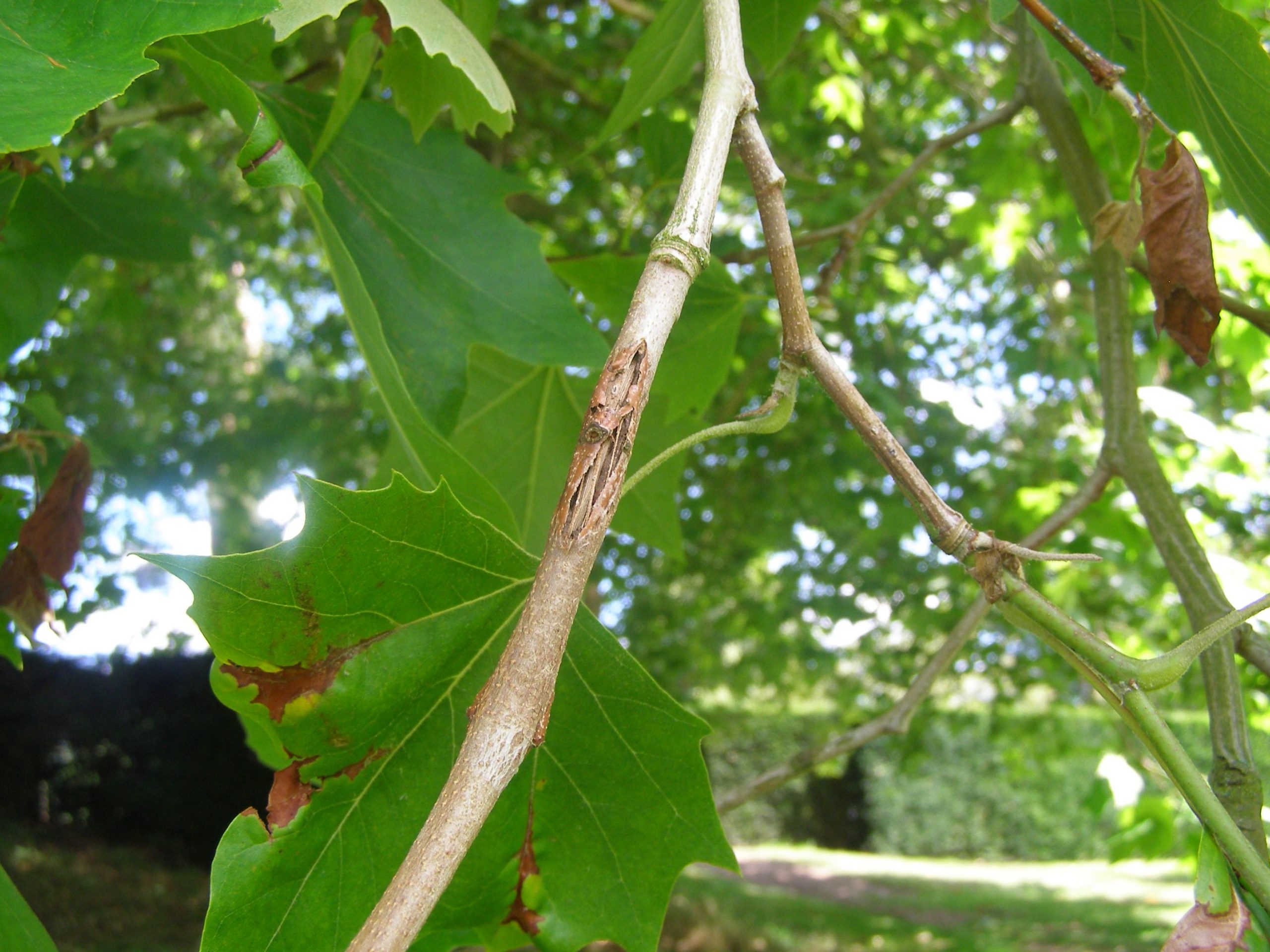Present in United Kingdom
Not notifiable
Scientific name of causal agent – Apiognomonia veneta

Anthracnose of plane is a foliar disease (a disease which affects leaves, twigs and buds) which can affect several species of plane trees (trees in the Platanus genus).
It is caused by the ascomycete fungus Apiognomonia veneta.
Anthracnose is common and widespread in many countries, among them the United Kingdom, continental Europe, the USA, Russia and New Zealand.
Western plane (Platanus occidentalis, also known as American sycamore) is highly susceptible to anthracnose. Oriental or Eastern plane (P. orientalis) is fairly tolerant, and the susceptibility of their hybrid, London plane (P. x acerifolia, syn. P. x hispanica), varies with the clone.
A. veneta infection causes bud damage, leaf wilting and twig blight on plane trees. Badly affected trees can suffer pronounced defoliation, and therefore become cosmetically unsightly, although the long-term impact on individual trees is usually relatively minor.
Plane trees are widely used in towns and cities as shade and amenity trees because they tolerate urban conditions well, including air pollution and water shortages.
They also suffer from other diseases, including Massaria, which is present in the UK, elbow-patch crust disease, and the usually fatal canker stain of plane. Canker stain is not thought to be here (as at 2020), but it is causing significant damage in continental Europe, including France.
The concern therefore is that the combined effects of the diseases, especially if canker stain was to enter the UK, might make their management too expensive for the local authorities and other public organisations which manage most of our plane trees, and they discontinue using plane. Few other tree species are as well-suited to the role currently fulfilled by plane trees.
Disease symptoms appear in the spring, when the fungus girdles the vascular tissue leading to the buds, causing bud blight. Where the twig tissue is completely encircled by the growing fungus the twigs die back causing twig blight, and cankers can develop on twigs and larger branches (top picture).
Shoot blight occurs later in the spring and early summer, when twigs are girdled after the leaves emerge. During the leaf blight stage the fungus kills tissue around the leaf veins, sometimes extending into the surrounding leaf tissue. The leaves develop brown staining along the veins and brown, crinkled patches on predominantly green leaves (top picture).
Anthracnose damage can be confused with frost damage. In cases of frost damage, however, there will be no signs of canker on the twigs, or staining of the wood below damaged buds.
Even severely affected trees usually recover to produce new growth by mid-summer. Tree vigour might be reduced, and branch growth distorted, if there is regular dieback. The disease tends to be more common in years with prolonged, mild, wet springs.
It is not necessary to report suspected cases of anthracnose of plane. Most plane trees in the UK are managed by organisations which have programmes of regular tree inspections by tree-care professionals who are trained to recognise and manage the disease.
The fungus over-winters in fallen leaves and one-year-old twigs, releasing spores from fruit bodies just as the buds begin to flush. Spores landing on emerging leaves cause shoot and leaf blight later in the spring.
Disease severity varies between years and is affected by the prevailing weather. Shoot blight usually develops after a period of cold spring weather, which slows the growth of the shoot and enables the fungus to colonise the shoot base.
Leaf blight is favoured by a warm and wet spring.
Twig and bud blight develop during warm spells during dormancy in winter. The fungus can continue to grow at these times, killing the bark.
The fungus becomes dormant in twigs and branches during the summer. At this time affected trees often produce new shoots and leaves which remain symptom-free, especially in hot, dry summers.
This disease is not generally thought to have a significant impact on the tree, although repeated year-on-year infections can reduce tree vigour. Most trees will re-flush by early to mid-summer, even when foliar damage is extensive in the spring.
Non-chemical, cultural methods can be used to control infection: rake up and burn fallen leaves, if practicable, to break the fungus’s life cycle. It might be possible to prune out affected twigs or branches on young, small trees.
Chemical treatment is not generally recommended for treatment of anthracnose in the UK, although it is sometimes practised in other countries.
As with many foliar pathogens, thinning the crown to increase air flow can reduce the severity of the disease.
Some cultivars of London plane are believed to tolerate anthracnose better than others, and it might be possible to select these when planting.
Practising high standards of biosecurity (plant hygiene) can help to prevent or minimise spread of the disease. This includes cleaning and disinfecting tools, clothes, vehicles and other equipment after working on infected trees, and before moving on to work on other trees. More-detailed guidance on tree biosecurity is available on the UK Government website.
Anthracnose of plane was first recorded in Britain in 1815, although its symptoms had been noted before then on western plane (Neely, 1976).
It is not clear whether A. veneta was introduced with plane trees, which are not native to the UK, or whether it was already present on other (unknown) host plant species.